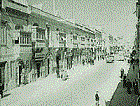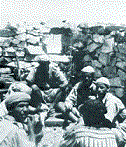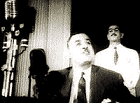Introduction
From Pirates to Grenades The lead up to the Violence

In 1839 Captain Haines of the East India Company landed a party of Royal Marines on the small seaport at the foot of the Red Sea. Haines's job was to put an end to the Adeni pirates who were harassing British merchant ships on their passage to India. For the next 50 years Aden was governed by the Bombay Presidency. With the opening of the Suez Canal in 1869 Aden became the main bunkering station for ships sailing to and from India. A large British garrison was also established to protect the southern approaches to the Suez Canal. For the next 95 years an Aden posting was to be a bleak prospect for any soldier, sailor or airman sent to the barren rocks. In 1956, after the loss of the Suez Canal, Aden became the main British base for her Far and Middle East interests. Aden also supported British Allies in the Middle East, including the Sheiks of the Trucial States. In 1961, 42 and 45 Commando Royal Marines were sent from Aden to Kuwait because of sabre rattling from Kuwait's neighbour Iraq.

By 1961 the Arabs in the Aden Protectorate and the Aden Colony believed that the "Winds of Change " were coming their way and that British rule would soon be over in Southern Arabia. Their thoughts and ideas were fuelled by President Nasser of Egypt, who encouraged the Arab peoples of South Arabia to cast out the British Colonial rulers of their lands. Aden was then made up two parts. Firstly the Aden Colony - just 70 square miles of rock and sand on the coast of the Red Sea. Within this area was the port of Aden, the airfield called RAF Khormaksar, the BP oil refinery, the town of Little Aden and the notorious Crater district, which housed seven hundred thousand Arabs. All of these lay around a natural deep-water harbour created by an extinct volcano.
The second part of British Aden was called the Aden Protectorate. This area was about the size of England and was split into two parts, the Eastern and the Western Protectorates. These Protectorates were crossed by two major roads. One road headed towards the British base at Dhala on the Yemen border while the other road ran into Yemen. The Dhala road was fiercely contested between local warring Arabs, British troops and the NLF who used the road to smuggle arms into Aden. When the Aden Protectorate was established in the 19th century, the British government had tried to quit successfully to band together the various Sheiks of the area. The hope was a united Arab force that would protect Aden from the neighing countries of Yemen and Saudi Arabia. To keep the Sheiks and themselves in line the British raised the Aden Protectorate Levies. This small army was made up of Arabs commanded by British officers mostly from the RAF regiment.
In 1958 President Nasser of Egypt formed the United Arab Republic with Syria and Yemen. The Imam of Yemen claimed that Aden belonged to Yemen and Nasser backed a Yemeni campaign of turning Arabs in the Protectorate against their Sheiks. The British counted this by convincing the Sheiks to make an alliance and join together to form the South Arabian Federation which would govern Aden once the British left.

The BP refinery in Aden had been built in 1954 and after the loss of the Suez Canal was heavily expanded. The new larger labour force for the refinery came mostly from Yemen. These workers soon out numbered the local Adeni workers and formed a trade union under the leadership of Abdullah Asnag from Yemen who was an extreme left wing socialist. Asnag claimed he wanted to expel the British from Aden and make Aden part of Yemen. This new country would be called The Democratic People's Republic of Yemen. Asnag organised strikes and demonstrations that were eventually to lead to the violence.

In September 1962 the Imam of Yemen died and his son Albadr became the new ruler of Yemen. One week later, the leader of the Yemen army, General Sallal, overthrew Albadr in a coup. Nasser, who sent two Egyptian divisions totalling 20,00 troops to Yemen to help the "Peoples struggle in Southern Arabia", backed this coup. In Aden Asnag and his followers greeted news of the coup with much happiness and demanded the immediate withdrawal of British troops from Aden so that the country could join the new Yemeni Republic.
The ousted Albadr fled to Saudi Arabia where he gained support from the Saudi king who was very alarmed by the socialist out breaks along his borders. With money from the Saudi King, Albadr bought weapons and started a guerrilla campaign against the forces of General Sallal and his Egyptian forces. As well as weapons, Albadr was offered the services of one Major John Copper (formerly 22 Sqn SAS) to help train his guerrilla bands. Copper was one of the original members of David Sterling's L Detachment in 1942, which later became the SAS. Copper and other former members of the SAS made the Yemeni mountains a very unpleasant place for Egyptians soldiers.

While this guerrilla war was taking place in Yemen, the "Voice of Arab Radio " was broadcasting anti-British propaganda to the people of Aden. The British government started to draw up plans for the withdrawal from Aden, setting the date for January 1968. The government also started to organise the still loyal Sheiks to form a Federation to run the country after the British withdrew. Asnag, on the other hand, had other ideas for the country after the British left. He wanted to form a Socialist Republic. His group was called People's Socialist Party ( PSP ), later turned into the Front for the Liberation of Occupied South Yemen or FLOSY for short . Members of FLOSY were made up of Aden townspeople. The National Liberation Front (NLF), the other organisation seeking power, was made up of Yemeni tribesmen from the hills. Both FLOSY and NLF wanted the British out and their party to take over Aden. Thus the battle lines were drawn.



